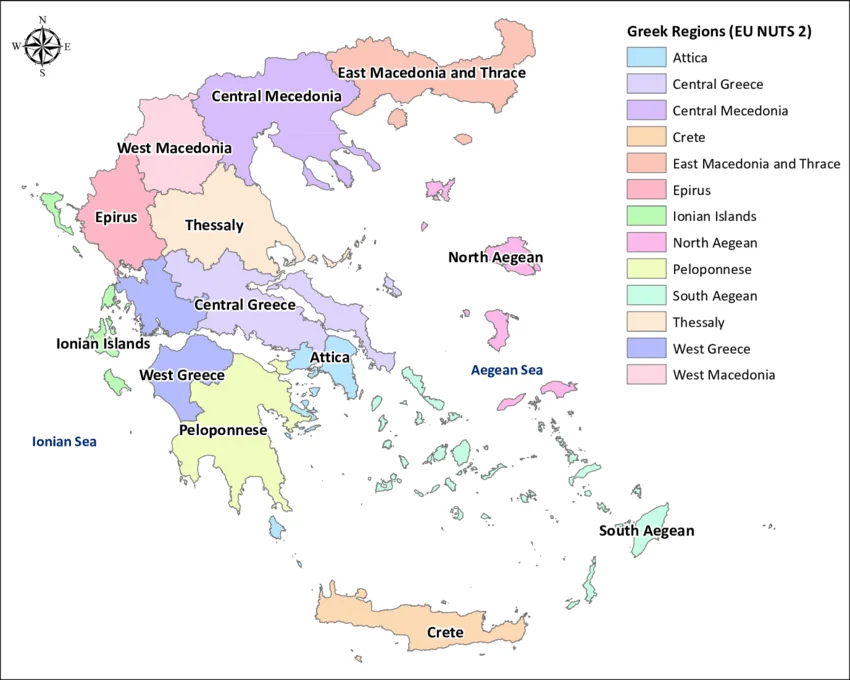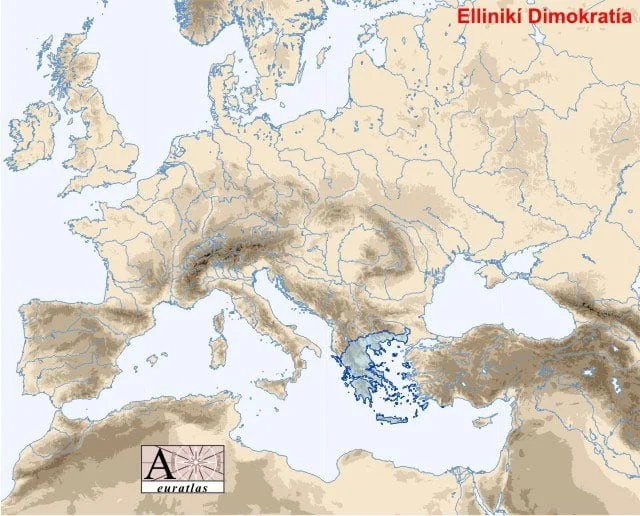Regions of Greece – Decentralized Administrations
Greece is divided into 13 administrative regions. The administrative regions of Greece are the thirteen first-level administrative units of the country that play an important role in decentralizing governance and promoting regional development.
These regions were established in 1986 to provide a modern structure for the country’s administration. This restructuring was based on earlier divisions, but adapted to the country’s evolving needs. The creation of these regions was a strategic move to strengthen local governance and promote balanced regional development.
Table of Contents

Greece covers an area of 50,949 square miles and is home to approximately 10.4 million people. The administrative regions of Greece serve as the backbone of the country’s administrative structure. These regions not only facilitate effective governance, but also contribute to the country’s economic development and cultural identity.
For example, Attica/Athens, the capital region, is the political, economic and cultural center of the country. On the other hand, regions such as the Aegean Islands and Crete are renowned for their natural beauty, attracting tourists from all over the world. These regions, with their unique characteristics and offerings, form the diverse tapestry of Greece, contributing to its rich cultural heritage and robust economy.
List of the 13 Regions of Greece
- Region of Attica
- Region of Central Greece
- Region of Central Macedonia
- Region of Crete
- Region of Eastern Macedonia and Thrace
- Region of Epirus
- Region of Ionian Islands
- Region of North Aegean
- Region of Peloponnese
- Region of Southern Aegean
- Region of Thessaly
- Region of Western Greece
- Region of Western Macedonia
*The Monastic Community of Mount Athos is an autonomous region under Greek sovereignty. (link)
Regional Governance
Each region in Greece is governed by a popularly elected regional governor and a regional council, both of whom serve five-year terms. This democratic system of regional government was introduced to replace the prefectures and decentralize power. Many of the powers of the prefectures were transferred to the regional level, allowing for more efficient administration and better representation of regional interests.
For example, the regional governor of Attica/Athens is responsible for addressing the specific needs of this densely populated urban region, while the regional governor of the Aegean Islands would focus on promoting tourism and preserving the natural environment. In this way, the regional governance system allows for tailored strategies and policies to meet the specific needs and characteristics of each region.
Administrative Regions and their Populations
- Attica is the most populous administrative region in Greece, which includes the Athens metropolitan area and is home to approximately 3,750,000 people.
- Central Macedonia follows as the second most populous region with a population of about 1,874,590 people.
- Thessaly is the third most populous region, with about 730,730 inhabitants.
The distribution of population across these administrative regions has implications for various sectors, including infrastructure, healthcare and education.
For example, the high population density in Attica requires robust urban infrastructure and extensive public services. Conversely, regions with lower population densities, such as the Aegean islands, may require a different approach focused on sustainable tourism and environmental protection. Understanding the distribution of population across Greece’s administrative regions is therefore key to effective planning and policy-making.
Size of the Administrative Regions
In terms of geographical size, Central Macedonia leads as the largest region in Greece, covering an area of about 7,262 square miles. Central Greece follows as the second largest region with an area of about 6,003.62 square miles. The different sizes of the administrative regions have a significant impact on the distribution of resources and the development of infrastructure.
For example, larger regions such as Central Macedonia may require more extensive transportation networks to facilitate connectivity within the region. On the other hand, smaller regions may focus more on the development of specific sectors, such as tourism in the Aegean islands. Thus, the size of administrative regions influences strategic planning and development initiatives in Greece.
Decentralized Administrations of Greece
In addition to the administrative regions, Greece also has seven decentralized administrations (link). These decentralized administrations group regions under a government-appointed Secretary General. They are designed to ensure the effective implementation of state policies at the regional level and serve as a bridge between the central government and the regional authorities.
This system of decentralized administrations facilitates greater coordination and cooperation between different levels of government. For example, during a national crisis, the secretary general of a decentralized administration can work closely with regional governors to ensure a unified and effective response. This system therefore plays a crucial role in the smooth functioning of public administration in Greece.
Attica / Athens
Attica, home to the Athens metropolitan area, is not only the most populous region in Greece, but also a major cultural, economic and political center. This region is home to approximately 3,750,000 people and includes major cities such as Athens, Piraeus and Marathon. As the capital region, Attica plays a prominent role in shaping the overall development of the country.
Attica is known worldwide for its iconic historical and cultural landmarks, such as the Acropolis and the Parthenon. The Temple of Poseidon at Cape Sounion, another major attraction, offers stunning views of the sea and is a testament to Greece’s ancient architectural prowess. These landmarks attract millions of tourists each year, contributing significantly to Attica’s economy and enhancing Greece’s global reputation as a top tourist destination.
Aegean Islands
The Aegean Islands, located in the Aegean Sea, are known for their breathtaking scenery, clear waters and beautiful beaches. This region consists of several islands, including popular tourist destinations such as Mykonos, Santorini and Rhodes. Each island has its own unique charm and attractions that contribute to the overall appeal of the Aegean Islands region.
Rich in history and culture, the Aegean Islands offer a glimpse into Greece’s past. Visitors can explore traditional villages, visit ancient archaeological sites and indulge in local cuisine. The region’s stunning natural beauty combined with its cultural heritage make the Aegean Islands a must-visit destination in Greece.
Central Greece
Located in the heart of the country, Central Greece is known for its diverse landscapes, including mountains, valleys and plains. This region includes important cities such as Lamia, Chalkida and Livadeia. Central Greece’s geographical location and natural resources play a significant role in its development and economy.
The region is particularly famous for its historical sites, such as Delphi and Meteora. Delphi, once considered the center of the world in ancient Greek mythology, is now an archaeological site with well-preserved ruins. Meteora, on the other hand, is known for its unique rock formations crowned with ancient monasteries. These sites attract history buffs and nature lovers alike, making central Greece a popular tourist destination.
Crete
Crete, Greece’s largest and most populous island, is known for its stunning scenery, rich history and vibrant culture. The main cities on the island are Heraklion, Chania and Rethymno. Crete’s geographical diversity, from sandy beaches to rugged mountains, offers visitors a unique experience.
Crete is also famous for its historical sites, especially those related to the ancient Minoan civilization, one of the earliest civilizations in Europe. The Palace of Knossos is a major archaeological site that showcases the advanced architecture and artistry of the Minoans. Crete’s combination of natural beauty and historical significance make it a popular choice for travelers exploring Greece.
Ionian Islands
Located in the Ionian Sea, the Ionian Islands are known for their lush green landscapes, pristine waters, and charming Venetian architecture. This region consists of several islands, including Corfu, Zakynthos and Kefalonia. Each of these islands offers a unique blend of natural beauty and cultural heritage, making the Ionian Islands an attractive tourist destination.
These islands are known for their stunning beaches, picturesque villages and vibrant cultural festivals. The unique Venetian architecture found in the region’s buildings and monuments reflects the islands’ historic ties to Venice. With their diverse offerings, the Ionian Islands provide visitors with a rich and enjoyable travel experience.
Northern Greece
Northern Greece, located in the northern part of the country, is defined by its diverse geography, which includes mountains, lakes, and coastal areas. This region includes major cities such as Thessaloniki, Kavala and Serres. Northern Greece’s geographical diversity contributes to its economic development and cultural richness.
The region offers a wide range of attractions, from historical sites such as the archaeological site of Philippi to natural landscapes such as Mount Olympus. Northern Greece is also known for its cultural festivals that showcase traditional Greek music, dance and cuisine. With its historical and natural attractions, Northern Greece offers visitors a unique travel experience.
Peloponnese
Peloponnese is a region in the southern part of Greece, known for its archaeological sites and beautiful scenery. This region includes important cities such as Patras, Kalamata and Corinth. The Peloponnese’s historical significance and natural beauty contribute to its appeal as a tourist destination.
The region is particularly famous for Ancient Olympia, the birthplace of the Olympic Games, and Mycenae, a fortified city from the ancient Mycenaean civilization. In addition to its historical sites, the Peloponnese offers beautiful scenery, including mountains, beaches and vineyards. Its diverse offerings make the Peloponnese a must-visit region in Greece.
Western Greece
Western Greece, located in the western part of the country, is known for its coastal areas, mountains and fertile plains. This region includes important cities such as Agrinio, Aigio and Missolonghi. The geographical diversity of Western Greece contributes to its economic development and cultural richness.
The region offers a mix of natural beauty and historical sites. Its beautiful coastal areas, such as the Ionian coast, attract beach lovers, while its picturesque landscapes and historical monuments, such as the ancient theater of Dodona, appeal to history buffs. With its diverse offerings, Western Greece provides visitors with an enriching travel experience.
Conclusion
Understanding the administrative regions of Greece is essential for effective governance, sustainable tourism and responsible industry development. Each of the thirteen administrative regions and the seven decentralized administrations, such as Attica/Athens, Aegean Islands, Central Greece, Crete, Ionian Islands, Northern Greece, Peloponnese and Western Greece, has its own unique characteristics and attractions.
Read more:





